2007 ISUZU KB P190 turn signal
[x] Cancel search: turn signalPage 1207 of 6020
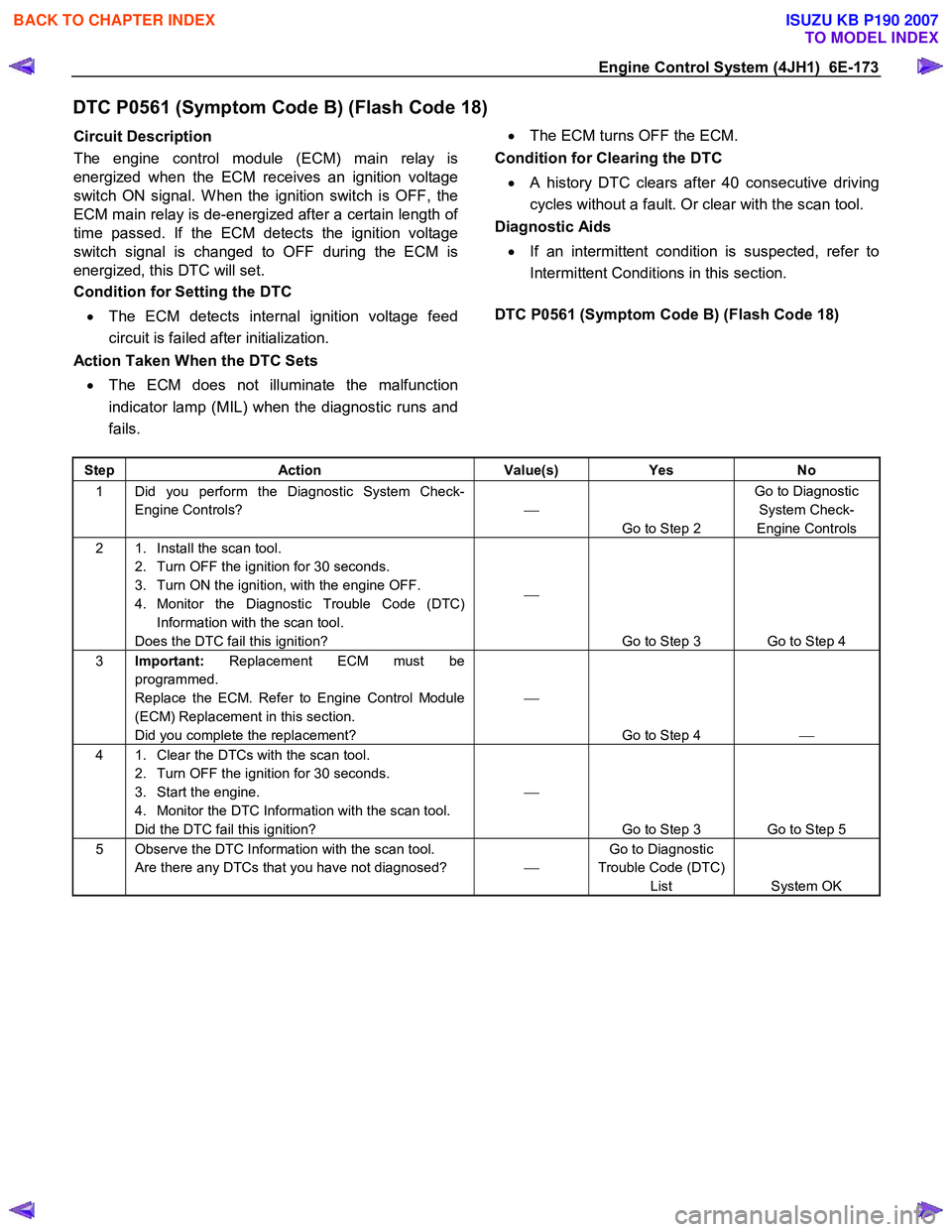
Engine Control System (4JH1) 6E-173
DTC P0561 (Symptom Code B) (Flash Code 18)
Circuit Description
The engine control module (ECM) main relay is
energized when the ECM receives an ignition voltage
switch ON signal. W hen the ignition switch is OFF, the
ECM main relay is de-energized after a certain length o
f
time passed. If the ECM detects the ignition voltage
switch signal is changed to OFF during the ECM is
energized, this DTC will set.
Condition for Setting the DTC
• The ECM detects internal ignition voltage feed
circuit is failed after initialization.
Action Taken When the DTC Sets
• The ECM does not illuminate the malfunction
indicator lamp (MIL) when the diagnostic runs and
fails.
•
The ECM turns OFF the ECM.
Condition for Clearing the DTC
• A history DTC clears after 40 consecutive driving
cycles without a fault. Or clear with the scan tool.
Diagnostic Aids
• If an intermittent condition is suspected, refer to
Intermittent Conditions in this section.
DTC P0561 (Symptom Code B) (Flash Code 18)
Step Action Value(s) Yes No
1 Did you perform the Diagnostic System Check-
Engine Controls?
Go to Step 2 Go to Diagnostic
System Check-
Engine Controls
2 1. Install the scan tool. 2. Turn OFF the ignition for 30 seconds.
3. Turn ON the ignition, with the engine OFF.
4. Monitor the Diagnostic Trouble Code (DTC) Information with the scan tool.
Does the DTC fail this ignition?
Go to Step 3 Go to Step 4
3 Important: Replacement ECM must be
programmed.
Replace the ECM. Refer to Engine Control Module
(ECM) Replacement in this section.
Did you complete the replacement?
Go to Step 4
4 1. Clear the DTCs with the scan tool.
2. Turn OFF the ignition for 30 seconds.
3. Start the engine.
4. Monitor the DTC Information with the scan tool.
Did the DTC fail this ignition?
Go to Step 3 Go to Step 5
5 Observe the DTC Information with the scan tool. Are there any DTCs that you have not diagnosed? Go to Diagnostic
Trouble Code (DTC) List System OK
BACK TO CHAPTER INDEX
TO MODEL INDEX
ISUZU KB P190 2007
Page 1215 of 6020

Engine Control System (4JH1) 6E-181
DTC P0703 (Symptom Code A, B) (Flash Code 25)
Circuit Description
The brake pedal switch is installed on the brake pedal
bracket. The brake pedal 1 switch is a normally open
type switch and the brake pedal 2 switch is a normally
closed type switch. W hen the brake pedal is pressed,
the brake pedal 1 switch signal is provided to the engine
control module (ECM) and the stoplights are turned ON.
Then, the brake pedal 2 switch signal to the ECM is
stopped (low voltage). If the ECM detects the brake
switch signals out of correlation, this DTC will set.
Condition for Running the DTC
• The ignition switch is ON.
• The engine speed is higher than 665 RPM.
• The vehicle speed is higher than 0 km/h (0 MPH).
Condition for Setting the DTC • The ECM detects that the brake pedal 1 switch
(normally open type switch) signal and brake pedal
2 switch (normally closed type switch) signal
correlation error for longer than 30 seconds within
the enabling conditions ever since ignition switch is
ON. (Symptom Code A)
• The ECM detects that the brake pedal 1 switch
(normally open type switch) signal and brake pedal
2 switch (normally closed type switch) signal
correlation error for longer than 30 seconds.
(Symptom Code B)
Action Taken When the DTC Sets
• The ECM illuminates the malfunction indicato
r
lamp (MIL) when the diagnostic runs and fails.
Condition for Clearing the MIL/DTC • The ECM turns OFF the MIL when the diagnostic
runs and does not fail.
• A history DTC clears after 40 consecutive driving
cycles without a fault. Or clear with the scan tool
Diagnostic Aids • If an intermittent condition is suspected, refer to
Intermittent Conditions in this section.
• Misadjusted brake pedal switch will cause this
DTC to set.
DTC P0703 (Symptom Code A, B) (Flash Code 25)
Schematic Reference: Engine Controls Schematics
Connector End View Reference: Engine Controls
Connector End Views or Engine Control Module (ECM)
Connector End Views
Step Action Value(s) Yes No
1 Did you perform the Diagnostic System Check-
Engine Controls?
Go to Step 2 Go to Diagnostic
System Check-
Engine Controls
2 1. Install the scan tool. 2. Turn ON the ignition, with the engine OFF.
3. Observe the Brake Pedal 1 Switch parameter with the scan tool while fully depressing and
releasing the brake pedal.
Does the scan tool indicate Applied when the brake
pedal is applied and Released when the brake pedal
is released?
Go to Step 10 Go to Step 3
3 1. Check to ensure the brake pedal switch is adjusted correctly. The plunger should be all the
way in when the pedal is released, yet should not
impede with the brake pedal full upward travel.
2. Adjust the brake pedal switch as necessary.
Did you find and correct the condition?
Go to Step 22 Go to Step 4
4 1. Turn OFF the ignition. 2. Inspect the Stop (15A) fuse (C-15) in the cabin fuse block.
Is the Stop (15A) fuse (C-15) open?
Go to Step 5 Go to Step 6
BACK TO CHAPTER INDEX
TO MODEL INDEX
ISUZU KB P190 2007
Page 1216 of 6020
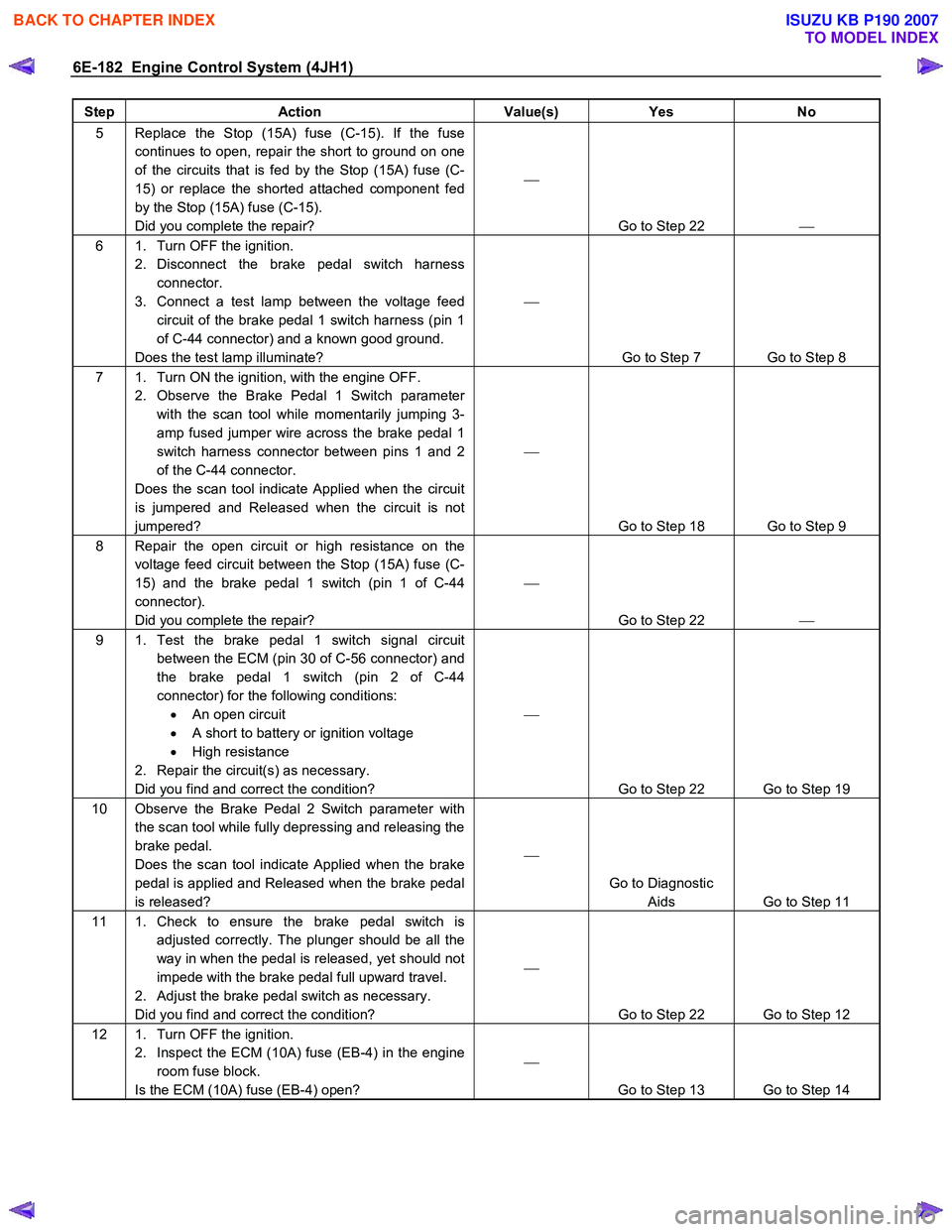
6E-182 Engine Control System (4JH1)
Step Action Value(s) Yes No
5 Replace the Stop (15A) fuse (C-15). If the fuse
continues to open, repair the short to ground on one
of the circuits that is fed by the Stop (15A) fuse (C-
15) or replace the shorted attached component fed
by the Stop (15A) fuse (C-15).
Did you complete the repair?
Go to Step 22
6 1. Turn OFF the ignition.
2. Disconnect the brake pedal switch harness connector.
3. Connect a test lamp between the voltage feed circuit of the brake pedal 1 switch harness (pin 1
of C-44 connector) and a known good ground.
Does the test lamp illuminate?
Go to Step 7 Go to Step 8
7 1. Turn ON the ignition, with the engine OFF. 2. Observe the Brake Pedal 1 Switch parameter with the scan tool while momentarily jumping 3-
amp fused jumper wire across the brake pedal 1
switch harness connector between pins 1 and 2
of the C-44 connector.
Does the scan tool indicate Applied when the circuit
is jumpered and Released when the circuit is not
jumpered?
Go to Step 18 Go to Step 9
8 Repair the open circuit or high resistance on the voltage feed circuit between the Stop (15A) fuse (C-
15) and the brake pedal 1 switch (pin 1 of C-44
connector).
Did you complete the repair?
Go to Step 22
9 1. Test the brake pedal 1 switch signal circuit
between the ECM (pin 30 of C-56 connector) and
the brake pedal 1 switch (pin 2 of C-44
connector) for the following conditions: • An open circuit
• A short to battery or ignition voltage
• High resistance
2. Repair the circuit(s) as necessary.
Did you find and correct the condition?
Go to Step 22 Go to Step 19
10 Observe the Brake Pedal 2 Switch parameter with the scan tool while fully depressing and releasing the
brake pedal.
Does the scan tool indicate Applied when the brake
pedal is applied and Released when the brake pedal
is released?
Go to Diagnostic Aids Go to Step 11
11 1. Check to ensure the brake pedal switch is
adjusted correctly. The plunger should be all the
way in when the pedal is released, yet should not
impede with the brake pedal full upward travel.
2. Adjust the brake pedal switch as necessary.
Did you find and correct the condition?
Go to Step 22 Go to Step 12
12 1. Turn OFF the ignition. 2. Inspect the ECM (10A) fuse (EB-4) in the engine room fuse block.
Is the ECM (10A) fuse (EB-4) open?
Go to Step 13 Go to Step 14
BACK TO CHAPTER INDEX
TO MODEL INDEX
ISUZU KB P190 2007
Page 1217 of 6020
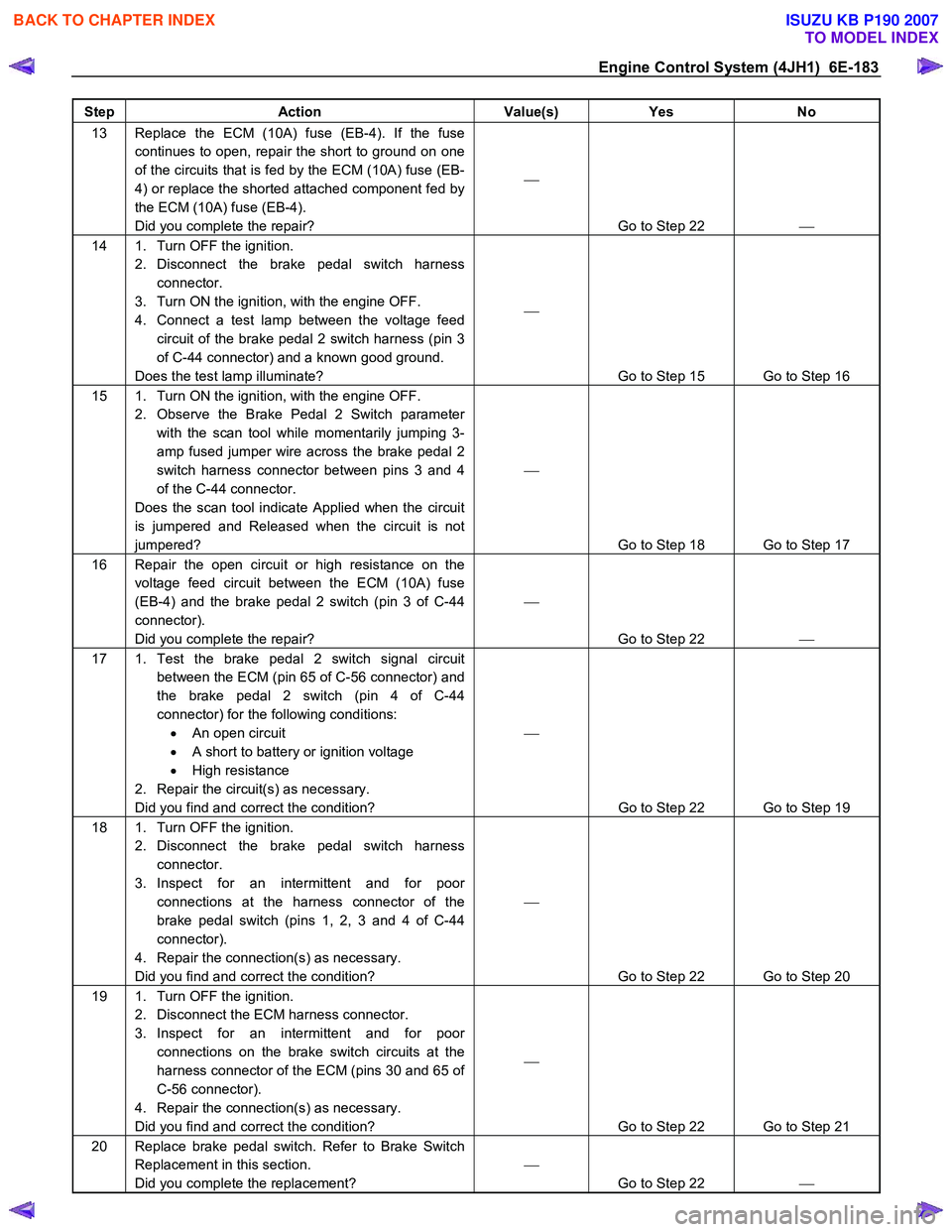
Engine Control System (4JH1) 6E-183
Step Action Value(s) Yes No
13 Replace the ECM (10A) fuse (EB-4). If the fuse
continues to open, repair the short to ground on one
of the circuits that is fed by the ECM (10A) fuse (EB-
4) or replace the shorted attached component fed by
the ECM (10A) fuse (EB-4).
Did you complete the repair?
Go to Step 22
14 1. Turn OFF the ignition.
2. Disconnect the brake pedal switch harness connector.
3. Turn ON the ignition, with the engine OFF.
4. Connect a test lamp between the voltage feed circuit of the brake pedal 2 switch harness (pin 3
of C-44 connector) and a known good ground.
Does the test lamp illuminate?
Go to Step 15 Go to Step 16
15 1. Turn ON the ignition, with the engine OFF. 2. Observe the Brake Pedal 2 Switch parameter with the scan tool while momentarily jumping 3-
amp fused jumper wire across the brake pedal 2
switch harness connector between pins 3 and 4
of the C-44 connector.
Does the scan tool indicate Applied when the circuit
is jumpered and Released when the circuit is not
jumpered?
Go to Step 18 Go to Step 17
16 Repair the open circuit or high resistance on the voltage feed circuit between the ECM (10A) fuse
(EB-4) and the brake pedal 2 switch (pin 3 of C-44
connector).
Did you complete the repair?
Go to Step 22
17 1. Test the brake pedal 2 switch signal circuit
between the ECM (pin 65 of C-56 connector) and
the brake pedal 2 switch (pin 4 of C-44
connector) for the following conditions: • An open circuit
• A short to battery or ignition voltage
• High resistance
2. Repair the circuit(s) as necessary.
Did you find and correct the condition?
Go to Step 22 Go to Step 19
18 1. Turn OFF the ignition. 2. Disconnect the brake pedal switch harness connector.
3. Inspect for an intermittent and for poor connections at the harness connector of the
brake pedal switch (pins 1, 2, 3 and 4 of C-44
connector).
4. Repair the connection(s) as necessary.
Did you find and correct the condition?
Go to Step 22 Go to Step 20
19 1. Turn OFF the ignition. 2. Disconnect the ECM harness connector.
3. Inspect for an intermittent and for poor connections on the brake switch circuits at the
harness connector of the ECM (pins 30 and 65 of
C-56 connector).
4. Repair the connection(s) as necessary.
Did you find and correct the condition?
Go to Step 22 Go to Step 21
20 Replace brake pedal switch. Refer to Brake Switch Replacement in this section.
Did you complete the replacement?
Go to Step 22
BACK TO CHAPTER INDEX
TO MODEL INDEX
ISUZU KB P190 2007
Page 1219 of 6020
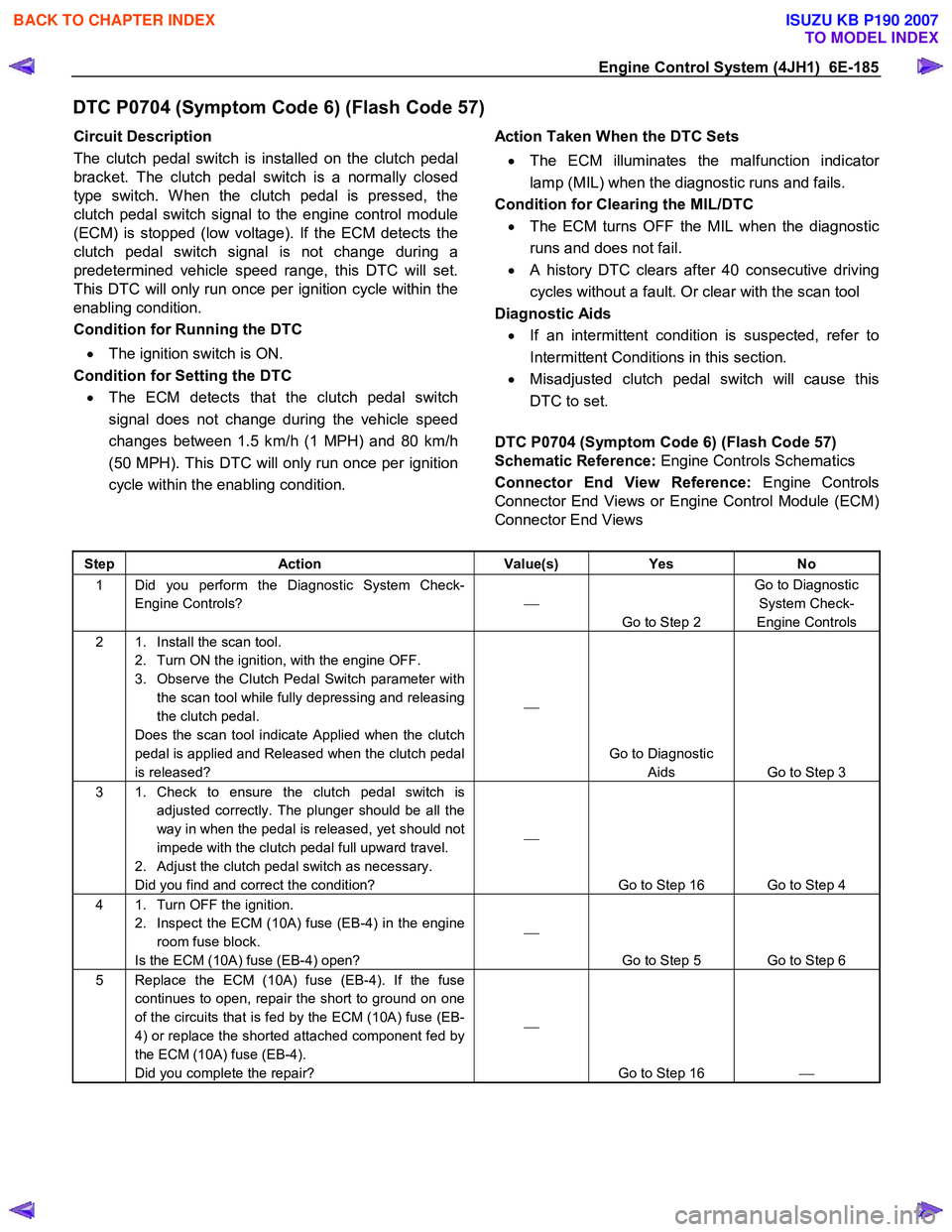
Engine Control System (4JH1) 6E-185
DTC P0704 (Symptom Code 6) (Flash Code 57)
Circuit Description
The clutch pedal switch is installed on the clutch pedal
bracket. The clutch pedal switch is a normally closed
type switch. W hen the clutch pedal is pressed, the
clutch pedal switch signal to the engine control module
(ECM) is stopped (low voltage). If the ECM detects the
clutch pedal switch signal is not change during a
predetermined vehicle speed range, this DTC will set.
This DTC will only run once per ignition cycle within the
enabling condition.
Condition for Running the DTC
• The ignition switch is ON.
Condition for Setting the DTC • The ECM detects that the clutch pedal switch
signal does not change during the vehicle speed
changes between 1.5 km/h (1 MPH) and 80 km/h
(50 MPH). This DTC will only run once per ignition
cycle within the enabling condition.
Action Taken When the DTC Sets
• The ECM illuminates the malfunction indicato
r
lamp (MIL) when the diagnostic runs and fails.
Condition for Clearing the MIL/DTC • The ECM turns OFF the MIL when the diagnostic
runs and does not fail.
• A history DTC clears after 40 consecutive driving
cycles without a fault. Or clear with the scan tool
Diagnostic Aids • If an intermittent condition is suspected, refer to
Intermittent Conditions in this section.
• Misadjusted clutch pedal switch will cause this
DTC to set.
DTC P0704 (Symptom Code 6) (Flash Code 57)
Schematic Reference: Engine Controls Schematics
Connector End View Reference: Engine Controls
Connector End Views or Engine Control Module (ECM)
Connector End Views
Step Action Value(s) Yes No
1 Did you perform the Diagnostic System Check-
Engine Controls?
Go to Step 2 Go to Diagnostic
System Check-
Engine Controls
2 1. Install the scan tool. 2. Turn ON the ignition, with the engine OFF.
3. Observe the Clutch Pedal Switch parameter with the scan tool while fully depressing and releasing
the clutch pedal.
Does the scan tool indicate Applied when the clutch
pedal is applied and Released when the clutch pedal
is released?
Go to Diagnostic Aids Go to Step 3
3 1. Check to ensure the clutch pedal switch is adjusted correctly. The plunger should be all the
way in when the pedal is released, yet should not
impede with the clutch pedal full upward travel.
2. Adjust the clutch pedal switch as necessary.
Did you find and correct the condition?
Go to Step 16 Go to Step 4
4 1. Turn OFF the ignition. 2. Inspect the ECM (10A) fuse (EB-4) in the engine room fuse block.
Is the ECM (10A) fuse (EB-4) open?
Go to Step 5 Go to Step 6
5 Replace the ECM (10A) fuse (EB-4). If the fuse continues to open, repair the short to ground on one
of the circuits that is fed by the ECM (10A) fuse (EB-
4) or replace the shorted attached component fed by
the ECM (10A) fuse (EB-4).
Did you complete the repair?
Go to Step 16
BACK TO CHAPTER INDEX
TO MODEL INDEX
ISUZU KB P190 2007
Page 1220 of 6020
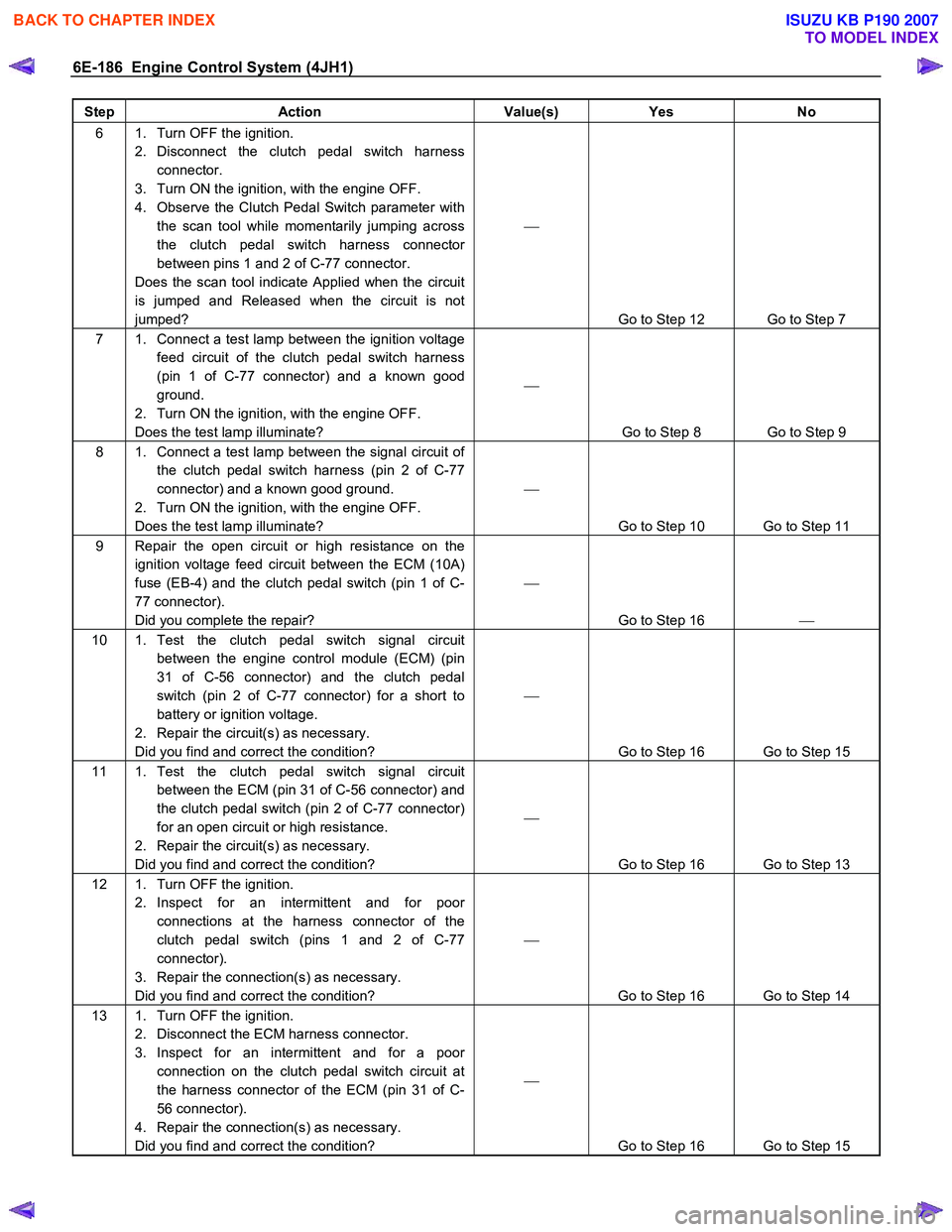
6E-186 Engine Control System (4JH1)
Step Action Value(s) Yes No
6 1. Turn OFF the ignition.
2. Disconnect the clutch pedal switch harness connector.
3. Turn ON the ignition, with the engine OFF.
4. Observe the Clutch Pedal Switch parameter with the scan tool while momentarily jumping across
the clutch pedal switch harness connector
between pins 1 and 2 of C-77 connector.
Does the scan tool indicate Applied when the circuit
is jumped and Released when the circuit is not
jumped?
Go to Step 12 Go to Step 7
7 1. Connect a test lamp between the ignition voltage feed circuit of the clutch pedal switch harness
(pin 1 of C-77 connector) and a known good
ground.
2. Turn ON the ignition, with the engine OFF.
Does the test lamp illuminate?
Go to Step 8 Go to Step 9
8 1. Connect a test lamp between the signal circuit of the clutch pedal switch harness (pin 2 of C-77
connector) and a known good ground.
2. Turn ON the ignition, with the engine OFF.
Does the test lamp illuminate?
Go to Step 10 Go to Step 11
9 Repair the open circuit or high resistance on the ignition voltage feed circuit between the ECM (10A)
fuse (EB-4) and the clutch pedal switch (pin 1 of C-
77 connector).
Did you complete the repair?
Go to Step 16
10 1. Test the clutch pedal switch signal circuit
between the engine control module (ECM) (pin
31 of C-56 connector) and the clutch pedal
switch (pin 2 of C-77 connector) for a short to
battery or ignition voltage.
2. Repair the circuit(s) as necessary.
Did you find and correct the condition?
Go to Step 16 Go to Step 15
11 1. Test the clutch pedal switch signal circuit between the ECM (pin 31 of C-56 connector) and
the clutch pedal switch (pin 2 of C-77 connector)
for an open circuit or high resistance.
2. Repair the circuit(s) as necessary.
Did you find and correct the condition?
Go to Step 16 Go to Step 13
12 1. Turn OFF the ignition. 2. Inspect for an intermittent and for poor connections at the harness connector of the
clutch pedal switch (pins 1 and 2 of C-77
connector).
3. Repair the connection(s) as necessary.
Did you find and correct the condition?
Go to Step 16 Go to Step 14
13 1. Turn OFF the ignition. 2. Disconnect the ECM harness connector.
3. Inspect for an intermittent and for a poor connection on the clutch pedal switch circuit at
the harness connector of the ECM (pin 31 of C-
56 connector).
4. Repair the connection(s) as necessary.
Did you find and correct the condition?
Go to Step 16 Go to Step 15
BACK TO CHAPTER INDEX
TO MODEL INDEX
ISUZU KB P190 2007
Page 1222 of 6020
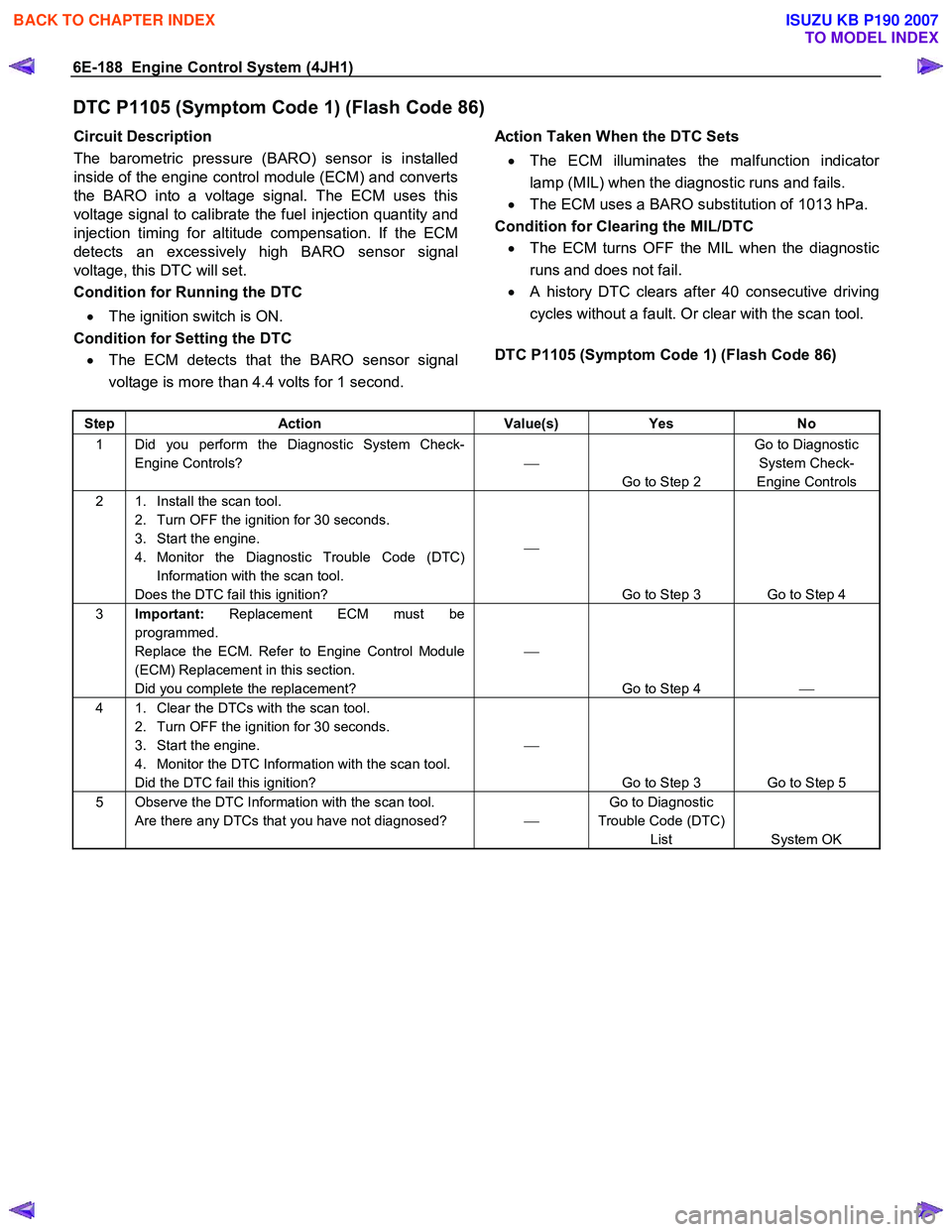
6E-188 Engine Control System (4JH1)
DTC P1105 (Symptom Code 1) (Flash Code 86)
Circuit Description
The barometric pressure (BARO) sensor is installed
inside of the engine control module (ECM) and converts
the BARO into a voltage signal. The ECM uses this
voltage signal to calibrate the fuel injection quantity and
injection timing for altitude compensation. If the ECM
detects an excessively high BARO sensor signal
voltage, this DTC will set.
Condition for Running the DTC
• The ignition switch is ON.
Condition for Setting the DTC
• The ECM detects that the BARO sensor signal
voltage is more than 4.4 volts for 1 second.
Action Taken When the DTC Sets
• The ECM illuminates the malfunction indicato
r
lamp (MIL) when the diagnostic runs and fails.
• The ECM uses a BARO substitution of 1013 hPa.
Condition for Clearing the MIL/DTC • The ECM turns OFF the MIL when the diagnostic
runs and does not fail.
• A history DTC clears after 40 consecutive driving
cycles without a fault. Or clear with the scan tool.
DTC P1105 (Symptom Code 1) (Flash Code 86)
Step Action Value(s) Yes No
1 Did you perform the Diagnostic System Check-
Engine Controls?
Go to Step 2 Go to Diagnostic
System Check-
Engine Controls
2 1. Install the scan tool. 2. Turn OFF the ignition for 30 seconds.
3. Start the engine.
4. Monitor the Diagnostic Trouble Code (DTC) Information with the scan tool.
Does the DTC fail this ignition?
Go to Step 3 Go to Step 4
3 Important: Replacement ECM must be
programmed.
Replace the ECM. Refer to Engine Control Module
(ECM) Replacement in this section.
Did you complete the replacement?
Go to Step 4
4 1. Clear the DTCs with the scan tool.
2. Turn OFF the ignition for 30 seconds.
3. Start the engine.
4. Monitor the DTC Information with the scan tool.
Did the DTC fail this ignition?
Go to Step 3 Go to Step 5
5 Observe the DTC Information with the scan tool. Are there any DTCs that you have not diagnosed? Go to Diagnostic
Trouble Code (DTC) List System OK
BACK TO CHAPTER INDEX
TO MODEL INDEX
ISUZU KB P190 2007
Page 1223 of 6020
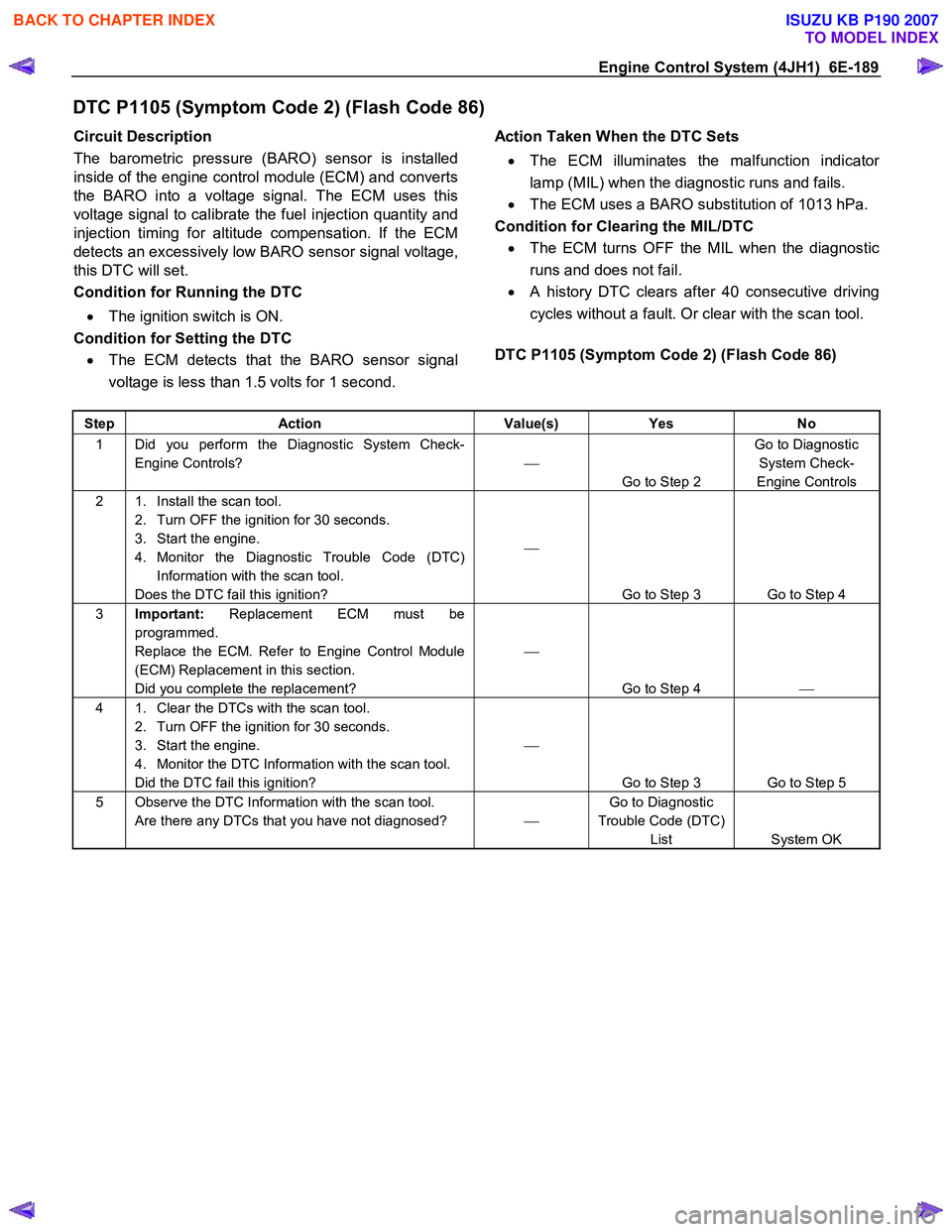
Engine Control System (4JH1) 6E-189
DTC P1105 (Symptom Code 2) (Flash Code 86)
Circuit Description
The barometric pressure (BARO) sensor is installed
inside of the engine control module (ECM) and converts
the BARO into a voltage signal. The ECM uses this
voltage signal to calibrate the fuel injection quantity and
injection timing for altitude compensation. If the ECM
detects an excessively low BARO sensor signal voltage,
this DTC will set.
Condition for Running the DTC
• The ignition switch is ON.
Condition for Setting the DTC
• The ECM detects that the BARO sensor signal
voltage is less than 1.5 volts for 1 second.
Action Taken When the DTC Sets
• The ECM illuminates the malfunction indicato
r
lamp (MIL) when the diagnostic runs and fails.
• The ECM uses a BARO substitution of 1013 hPa.
Condition for Clearing the MIL/DTC • The ECM turns OFF the MIL when the diagnostic
runs and does not fail.
• A history DTC clears after 40 consecutive driving
cycles without a fault. Or clear with the scan tool.
DTC P1105 (Symptom Code 2) (Flash Code 86)
Step Action Value(s) Yes No
1 Did you perform the Diagnostic System Check-
Engine Controls?
Go to Step 2 Go to Diagnostic
System Check-
Engine Controls
2 1. Install the scan tool. 2. Turn OFF the ignition for 30 seconds.
3. Start the engine.
4. Monitor the Diagnostic Trouble Code (DTC) Information with the scan tool.
Does the DTC fail this ignition?
Go to Step 3 Go to Step 4
3 Important: Replacement ECM must be
programmed.
Replace the ECM. Refer to Engine Control Module
(ECM) Replacement in this section.
Did you complete the replacement?
Go to Step 4
4 1. Clear the DTCs with the scan tool.
2. Turn OFF the ignition for 30 seconds.
3. Start the engine.
4. Monitor the DTC Information with the scan tool.
Did the DTC fail this ignition?
Go to Step 3 Go to Step 5
5 Observe the DTC Information with the scan tool. Are there any DTCs that you have not diagnosed? Go to Diagnostic
Trouble Code (DTC) List System OK
BACK TO CHAPTER INDEX
TO MODEL INDEX
ISUZU KB P190 2007